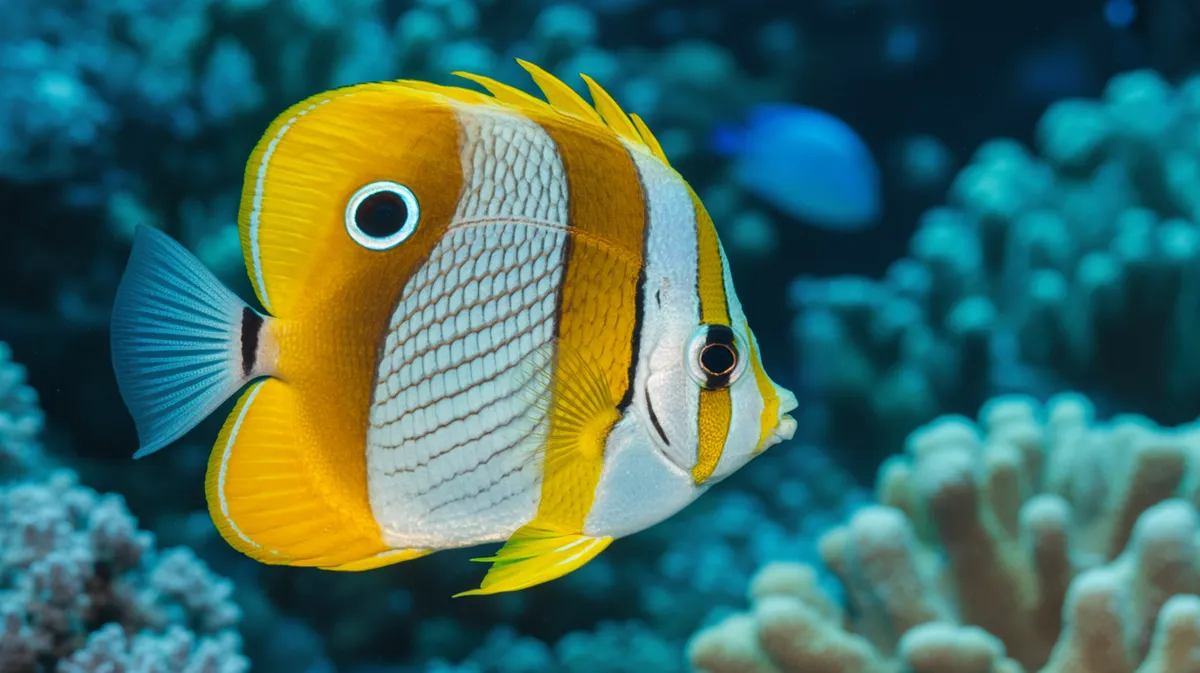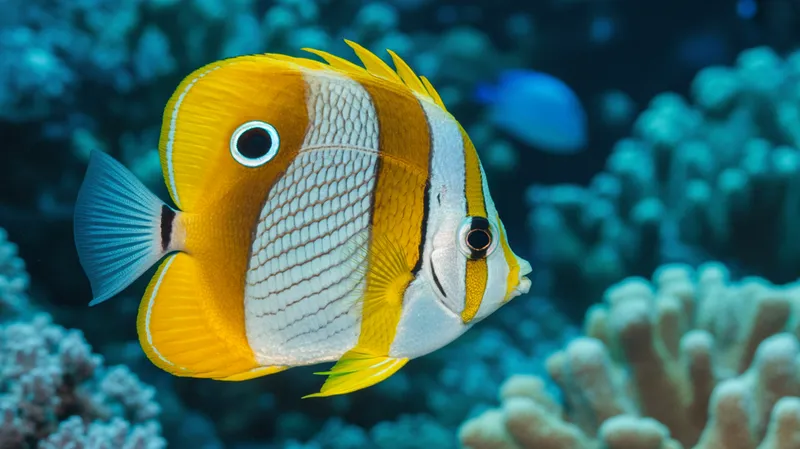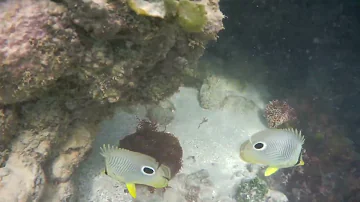
Foureye Butterflyfish
Chaetodon capistratus

Meet the Foureye Butterflyfish
The Foureye Butterflyfish is a striking marine fish known for the large, dark eyespot ringed in white on the rear portion of each side of its body, which confuses predators and gives the fish its common name. Its body is laterally compressed and displays a silvery-white color with thin, dark diagonal bands and a bold, vertical black bar through the eye. Commonly found in shallow coral reefs of the western Atlantic Ocean, it is a diurnal species that feeds primarily on invertebrates and coral polyps. The Foureye Butterflyfish is typically seen alone or in pairs, especially during breeding, and is highly maneuverable, able to dart between coral branches with ease.
Classification
Fish
Habitat
Coral reefs
Diet
Omnivore
Lifespan
5-7 years
Conservation
Least Concern
Weight
15-25 grams
📖Fascinating Facts
False Eyes
The large eyespot near its tail confuses predators, making them attack the less vulnerable tail end instead of the head.
Monogamous Pairs
Foureye Butterflyfish often form long-term monogamous pairs and are commonly seen swimming together.
Coral Specialists
Their diet includes coral polyps, making them important members of coral reef ecosystems but also sensitive to reef degradation.
📋Detailed Description
The Foureye Butterflyfish (Chaetodon capistratus) is a small, laterally compressed marine fish, typically reaching a maximum length of 15 cm (about 6 inches), though most adults measure 8–12 cm. Its most distinctive feature is the large, dark ocellus (false eyespot) ringed in white on the rear portion of each flank, which serves as a predator deterrent by confusing attackers about the fish's true head orientation. The body is silvery-white, adorned with a series of thin, dark diagonal bands, and a bold, vertical black bar running through the eye, further camouflaging the actual eye. The dorsal fin is continuous, with 12–13 spines and 19–21 soft rays, while the anal fin has 3 spines and 17–19 soft rays. The mouth is small and terminal, adapted for picking at small prey among coral branches. Foureye Butterflyfish are agile swimmers, capable of rapid, precise movements that allow them to navigate complex reef structures. They are generally solitary but are frequently observed in monogamous pairs, especially during breeding periods. Juveniles are secretive, often hiding among branching corals for protection. This species is diurnal, actively foraging during the day and seeking shelter in reef crevices at night. Their coloration and patterns provide effective camouflage among the coral and rubble habitats they frequent.
💡 Did you know?
Despite their delicate appearance, Foureye Butterflyfish are highly territorial and will vigorously defend their chosen patch of reef from intruders.
🔬Research & Sources
Wikipedia Summary
The foureye butterflyfish is a butterflyfish. It is alternatively called the four-eyed butterflyfish. This species is found in the Western Atlantic from Massachusetts, USA and Bermuda to the West Indies and northern South America.
Last Modified: 1/5/2025
🎭Behavior & Social Structure
Foureye Butterflyfish exhibit a range of complex behaviors adapted to their coral reef environment. They are primarily diurnal, spending daylight hours actively foraging for food, which includes a variety of invertebrates such as polychaete worms, gorgonian polyps, and small crustaceans, as well as algae and coral mucus. Their feeding strategy involves pecking at the substrate with their small, protrusible mouths, often targeting the bases of gorgonians and soft corals. Socially, adults are most often seen in stable pairs, which are thought to be monogamous and may defend small territories together. These pairs engage in coordinated swimming and mutual displays, especially during courtship. Juveniles are more secretive and solitary, utilizing cryptic coloration and hiding in coral branches to avoid predation. At night, individuals seek shelter in crevices or under ledges, reducing activity to avoid nocturnal predators. When threatened, the fish often orient their bodies so the false eyespot faces the predator, then dart away in the opposite direction.
👶Reproduction & Life Cycle
Reproduction in Foureye Butterflyfish is oviparous, with external fertilization. Spawning typically occurs during the warmer months, often at dusk, and is synchronized with lunar cycles in some regions. Pairs engage in elaborate courtship displays involving circling, parallel swimming, and mutual fin displays. During spawning, the pair ascends into the water column, releasing eggs and sperm simultaneously. The eggs are pelagic, spherical, and buoyant, hatching after approximately 24–48 hours depending on water temperature. Larvae are planktonic for several weeks, undergoing significant morphological changes before settling onto the reef as juveniles. There is no parental care after spawning; survival of offspring depends on dispersal and successful settlement in suitable habitats.
🛡️Adaptations & Survival
The Foureye Butterflyfish possesses several notable adaptations for survival in coral reef ecosystems. The prominent eyespot near the tail confuses predators, increasing the fish's chances of escape by directing attacks away from the vulnerable head. The vertical black bar through the real eye further obscures its location. Their laterally compressed bodies and flexible pectoral fins enable precise maneuvering among coral branches and tight spaces. The small, pointed mouth is specialized for picking at small prey items and scraping food from hard surfaces. Their coloration provides camouflage against the complex backgrounds of coral reefs. Socially, their tendency to form monogamous pairs may enhance territory defense and reproductive success. Additionally, their ability to utilize a varied diet, including both animal and plant matter, allows them to exploit a range of food resources.
📚Research Sources
🎨Cultural Significance
While the Foureye Butterflyfish does not hold major significance in traditional folklore or mythology, it is a popular species in the marine aquarium trade due to its striking appearance and relative hardiness. It is frequently featured in educational materials and ecotourism promotions as an emblematic reef fish of the Caribbean and Western Atlantic. Its presence is often used as an indicator of healthy coral reef ecosystems, and it serves as a flagship species for reef conservation efforts in the region.
🔬Recent Research & Discoveries
Recent research on Chaetodon capistratus has focused on its role as an indicator species for coral reef health, given its reliance on coral-rich habitats. Studies have examined its feeding ecology, demonstrating dietary flexibility that may buffer it against coral loss compared to more specialized butterflyfish. Genetic analyses have explored population connectivity across the Caribbean, revealing high gene flow and suggesting resilience to localized disturbances. Ongoing research is investigating the impacts of climate change and coral bleaching on its distribution and reproductive success. Behavioral studies have documented the mechanisms and effectiveness of the eyespot in predator avoidance, providing insights into the evolution of mimicry and deceptive coloration in reef fishes.
🎥Wildlife Videos

Butterfly Fish In The Sea - Dive With Fishes - Marine Life Documentary
Friends of Oceans Channel creates a Marine Life Documentary, On Ocean Life of Fishes Foureye butterflyfish are deep-bodied ...
Friends Of Oceans

Four-eyed Butterflyfish (Chaetodon capistratus) at the White River Fish Sanctuary
A couple of Four-eyed Butterflyfish (Chaetodon capistratus) swimming in the shallows of the White River Fish Sanctuary, St Ann, ...
LogansWildlifePhotography

Butterfly Fish Facts | Animl Facts | species of marine fish found in tropical and subtropical waters
pet #animal This video answers below listed questions. How many butterfly fish are left? Where does butterfly fish live? How much ...
Animal Square

Pair of Four eye Butterfly Fish
January 21, 2018 - Roatan, Honduras, Infinity Bay Spa & Beach Resort - Pair of Four eye Butterfly Fish.
Peter Michael Photography

Bluecheek Butterfly fish/Golden Butterfly Fish - Marine Life Documentary
Bluecheek Butterflyfish is also known as Addis Butterflyfish, Masked Butterflyfish, Blue-cheeked Butterflyfish, Bluemask ...
Friends Of Oceans

Facts: The Foureye Butterflyfish
Quick facts about this colorful, compressed fish with fake eyes! The foureye butterflyfish (Chaetodon capistratus, four-eyed ...
Deep Marine Scenes
🌍Habitat Information
The Foureye Butterflyfish typically inhabits Coral reefs environments. Foureye Butterflyfishs have adapted to their environments with specialized features and behaviors.
Primary Habitat:
Coral reefs
More detailed habitat information will be available soon.
🛡️Conservation Status
The Foureye Butterflyfish is currently classified as Least Concern. Conservation efforts are crucial for preserving this species for future generations.
Common Threats:
- 🏠Habitat loss and fragmentation
- 🌡️Climate change impacts
- 🎯Hunting and poaching
- 🏭Human-wildlife conflict
⚠️Threats & Conservation Challenges
Currently assessed as Least Concern by the IUCN, the Foureye Butterflyfish faces localized threats primarily from habitat degradation. Coral reef decline due to climate change, ocean acidification, coral bleaching, and destructive fishing practices (such as the use of cyanide or dynamite) can reduce available habitat and food sources. Collection for the aquarium trade poses a minor threat in some regions, though this species is less targeted than other butterflyfish. Pollution, coastal development, and sedimentation also impact reef health and, consequently, butterflyfish populations. Despite these challenges, the species remains widespread and abundant throughout its range, with stable population trends reported in most areas.
🔬Scientific Classification
Scientific Name
Chaetodon capistratus
Classification Hierarchy
🔍 About Taxonomic Classification
Taxonomic classification is a hierarchical system used by scientists to classify and organize living organisms based on shared characteristics and evolutionary relationships.
The system moves from broad categories (Kingdom) to increasingly specific ones, with each animal's scientific name typically consisting of its Genus and species.
📝Community Notes
Share your observations and insights about the Foureye Butterflyfish with our community of wildlife enthusiasts.
Join Our Community
Sign in to share your observations and connect with fellow wildlife enthusiasts.
Sign In to ContributeNo community notes yet
Be the first to share your observations about the Foureye Butterflyfish!
Explore Foureye Butterflyfish
Select a tab above to learn more about this amazing animal.
📸Photo Gallery
No photos available for this animal yet.
🌟Discover More Wildlife
Continue your journey of discovery with more fascinating animals from our database
